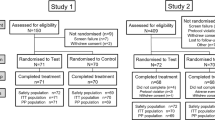Abstract
Data sources
PubMed, Cochrane Central Register of Controlled trials (CENTRAL) in Cochrane Library and Embase. A manual search of the relevant articles was also applied to identify additional studies. Only articles published in English were selected. Contact with the author of a study was attempted if there was insufficient information in publication.
Study selection
Two authors independently assessed the eligibility of all studies retrieved from the databases. Only randomised controlled trials reporting the effect of toothpaste on dentine hypersensitivity were included.
Data extraction and synthesis
Two authors independently abstracted data and bias was assessed using the Cochrane Collaboration tool for risk of bias. Standardised mean differences and 95% confidence intervals were calculated and random effects meta-analysis conducted.
Results
Thirty-one RCTs involving a total of 2436 patients were included. A majority of studies (23) were considered to be of moderate quality, three of high quality and five of low quality. Meta-analysis showed that five of the toothpastes had a desensitising effect with only strontium-containing toothpastes having no significant effect.
Conclusions
The review found sufficient evidence to support the use of potassium-, stannous fluoride-, calcium sodium phosphosilicate- and arginine-containing desensitising toothpaste for dentine hypersensitivity. It found no significant desensitising effect difference between strontium-containing toothpaste and a placebo.
Similar content being viewed by others
Commentary
Dentine hypersensitivity is one of the most common types of dental pain, affecting as many as 42%1 of the young adult (18-35) population. The pain, usually sharp and of short duration, arises from stimuli to exposed dentinal surfaces. The most common trigger is cold, either from air or liquid. Considering that the condition is so common and can affect the quality of one's life, a simple, effective, noninvasive treatment is the searched-for goal. Brushing with a desensitising toothpaste would be an ideal treatment. The purpose of this systematic review is to determine if, and which, toothpastes work.
The author's meta-analysis of 31 studies showed that toothpastes containing potassium, stannous fluoride, calcium sodium phosphosilicate and arginine were all statistically effective in reducing sensitivity. Strontium containing toothpaste was not effective. There are numerous reviews that conclude with conflicting results. Some conclude that potassium and strontium show weak effect,2, 3, 4 while most say that arginine is stronger.3,4 One review mentioned a study showing arginine as being weaker.3 Some reviews note the difficulty of bias and heterogeneity as being problematic in most studies.1,3
This review was not without bias. Only 12 of the 31 studies were of low risk of bias for allocation concealment. The authors also stated that all included studies were sponsored by the manufacturers (funding bias) and that there was high heterogeneity (I2=96%) of the included studies. In order to minimise heterogeneity, the authors focused on studies that used an air blast as the stimulus. They felt that this was more controllable and reproducible than using tactile or chemical stimuli. This may also be more practical, as most people come in contact with cold (cold drinks, food, frigid air) more often than other stimuli.
Finally, including studies for strontium of only three and seven days, and minimising the weeks (six, six, eight) as compared to arginine (five studies of eight weeks) was, perhaps, a form of inclusion bias. The authors, in their discussion, did mention that some studies were measuring immediate affect and some lasting affect. To include both only adds to the heterogeneity. Their conclusion mentioned that home treatments should go hand in hand with in-office dental treatment.
In conclusion the review did present some positive findings. It may be stated that current desensitising toothpastes containing potassium, stannous fluoride, calcium sodium phosphosilicate and arginine with calcium carbonate do effectively desensitise teeth. However, although statistically significant, the clinical relevance of improvement is small. There was a difference of decreased hypersensitivity of only 1.85 out of a scale of ten. Although the authors found that strontium acetate toothpaste had no effect, perhaps different inclusion criteria would better test the effectiveness of strontium acetate. In conclusion with the authors, further studies of well-designed randomised trials are needed to test both immediate and lasting effects.
There is evidence to show that many desensitising toothpastes do reduce hypersensivity, but not strongly. Further well-designed randomised trials are needed. The fact that there are so many variables when it comes to tooth pain, makes consultation with a dentist important.
References
West NX, Seong J, Davies M . Management of dentine hypersensitivity: efficacy of professionally and self-administered agents. J Clin Periodontol. 2015; 42: S256–S302.
Karim BF, Gillam DG . The efficacy of strontium and potassium toothpastes in treating dentine hypersensitivity: a systematic review. Int J Dent 2013; 573258 doi: 10.1155/2013/573258. Epub 2013 Apr 8.
Magno MB, Nascimento GC, Da Penha NK, Pessoa OF, Loretto SC . Maia LC Difference in effectiveness between strontium acetate and arginine-based toothpastes to relieve dentin hypersensitivity. A systematic review. Am J Dent 2015; 28: 40–44.
Yan B, Yi J, Li Y, Chen Y, Shi Z . Arginine-containing toothpastes for dentin hypersensitivity: systematic review and meta-analysis. Quintessence Int 2013; 44: 709–723.
Author information
Authors and Affiliations
Additional information
Address for correspondence: Ji-Hyun Bae, Department of Conservative Dentistry, Section of Dentistry, Seoul National University, Bundang Hospital, 300 Gumi-dong, Bundang-gu Seongnam-si, Gyeonggi-do 463-707, Korea. E-mail: beigeh@snubh.org
Bae JH, Kim YK, Myung SK. Desensitizing toothpaste versus placebo for dentin hypersensitivity: a systematic review and meta-analysis. J Clin Periodontol 2015; 42: 131–141. doi: 10.1111/jcpe.12347. Epub 2015 Jan 9. PubMed PMID: 25483802.
Rights and permissions
About this article
Cite this article
Levenson, D. Beneficial effects seen with most desensitising toothpastes. Evid Based Dent 17, 10–11 (2016). https://doi.org/10.1038/sj.ebd.6401147
Published:
Issue Date:
DOI: https://doi.org/10.1038/sj.ebd.6401147



